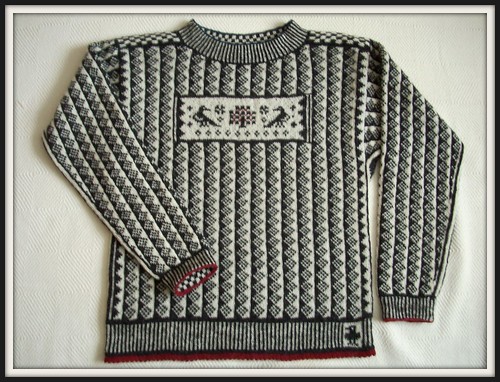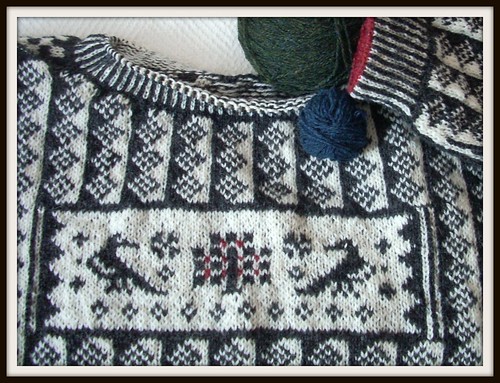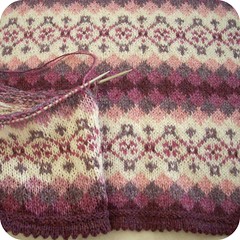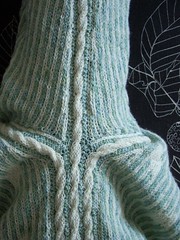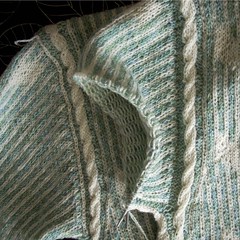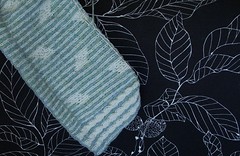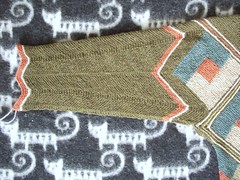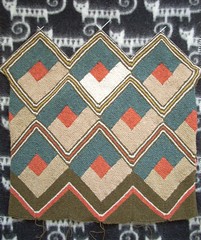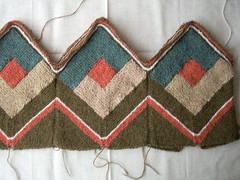Monday, 20 February 2012
Time to go fishing
One of the many things I love about this yarn, BC Shetlandsuld, is how soft it becomes once the garment is washed and blocked. It's slightly rough to work with, which I like, but not scratchy to wear.
Bernadette asked what I think of Drops Lace, which I mentioned in my previous post. I think it's a very nice yarn for shawls. I'm not very fond of 100% alpaca, but it makes a huge diffence that it's a alpaca-silk blend. The silk not only adds some weight and a lovely sheen, but it also makes it less slippery to work with. It's the first time I try it, though, so I don't know yet how it will be affected by washing and blocking. To be continued!
I was lucky enough to win the latest book from Korsstygnsbolaget in a lottery! As "The winner takes it all" I'm going to keep the sweater for myself too - but I will make an exception when it comes to the shawl :)
BC Shetlandsuld är ett av mina favoritgarner: det är lite strävt att arbeta med, vilket jag gillar, men blir mjukt när man tvättar och sträcker det färdigstickade plagget. Nu väntar jag bara på att "Thorsten fiskares tröja" (från "Ylle & bläck" av Celia B. Dackenberg fast med en del ändringar) ska torka, så att jag kan prova den.
Apropå garner, i mitt förra inlägg skrev jag att jag håller på med en sjal i Drops Lace. Det är första gången jag stickar med det och jag tycker att det verkar vara ett riktigt bra sjalgarn. Jag är inte så förtjust i ren alpacka (för halkigt för min smak) men det gör stor skillnad att det är blandat med silke. Det får lite tyngd och en så fin lyster också. Återstår bara att se hur det beter sig när det tvättas och sträcks.
Monday, 6 February 2012
All these choices - alla dessa val
Another friend joked about my initials on the gusset: "Does it stand for i armhålan (in the armpit)?" A week later it still makes me laugh :)
I first tried joining body and saddle using a three-needle bind-off, but it resulted in rather too thick ridges on the wrong side, so I'm grafting them like Maria suggested.
Friends in need!
 |
| grafting - maskstygn |
En annan vän fällde en kommentar om initialerna på ärmkilen som fortfarande får mig att skratta högt: "Står det för i armhålan?"
Jag håller på och monterar sadeln med maskstygn, som Maria föreslog. Först provade jag att plocka upp maskor längs kanterna och avmaska dem tillsammans med maskorna på fram- respektive bakstyckena, men det blev lite för stumt och klumpigt på avigsidan.
Thursday, 22 September 2011
Twined knitting with two colours
The other day I saw super knitter Tålamodspåsen's phone case and thought I'd make one for myself to test a couple of pattern ideas for twined knitting.
For easy comparison I like having different versions of the same idea in a swatch, in this case a pattern with knit stitches and then with both knit and purl stitches. Not only do they look and feel slightly different, the one with purls is thicker too.
Twined knitting with two colours looks a bit like mosaic knitting, but there are major differences. In mosaic knitting you knit with one colour at a time and slip stitches to make a pattern; in twined knitting you knit with both colours and cover stitches with the strand you don't knit with to make a pattern. I haven't knitted much mosaic knitting, but it seems to me it tends to curve (depending on the pattern) in a way twined knitting doesn't. Not that it's a bad thing necessarily - I can see how it could be an effect you'd want to achieve.
 |
| All the twisting makes it necessary to unwind the two strands every now and then. Having just one ball of yarn makes it easier: you just let it hang in the air. |
Edited to add: how I wish I could draw like Mattias!
Wednesday, 26 January 2011
Teeth galore
I made the steek rather wide, since I didn't want to cut it open in the middle but to cut out the middle part of it with all the dangling threads.
 |
| This is what the wrong side looks like. |
Friday, 21 January 2011
Jaws
The centre back and front sections are finished; right now I am crocheting "seams" in the steeks before cutting them to secure the strands. Next step will be joining the shoulders and then pick up stiches along the whole back and front to knit side panels and sleeves.
Wednesday, 12 January 2011
Returning to Marianne Isager
Knitting lace shawls is great, but so is variation - so I've been looking for inspiration in my knitting books. Trust Marianne Isager! Here's an intriguing design in "Inca Knits" that I haven't paid much attention to before, but which kind of gave my stash a come-hither stare.
The construction is one I haven't tried and never would have thought of, for that matter. First you knit the multi-coloured sections of the back and front; then you pick up stitches along the sides to knit not only the sleeves but also the side panels.
Any modif
 ications? Yes!
ications? Yes!1. Colours. I'm using greyish brown and natural white Shetlandsuld I bought about half a year ago when my LYS celebrated 25 years. I'm spicing it with some leftovers from Zaire. The photo to the left does not do the colours justice, but will at least give you an idea.
2. I'm not knitting the multi-coloured sections back and forth, but in the round with steeks. A bonus is not having to weave in any ends: I start new rows in the middle of a steek and will simply cut the steeks open and trim the edges.
3. Minor modifications in the pattern with an extra colour and two stocking stitch rows skipped between purl ridges.
Saturday, 10 July 2010
"Kungsängslilja" no 2
I'm knitting a new version of a vest I made in November. They're practically identical; however, I'm modifying the shape slightly and have chosen a different shade of lighter pink. I think I prefer the new combination. There's more contrast in the first version, which I think creates visual interest, but the softer change in the second version appeals to me too.
Hard as it may be to believe, I had to have a break from knitting for a few days as my left shoulder was too sore. I first thought it might be due to spending an afternoon crocheting the bind-off edge around the Springtime shawl, but have decided to blame it on cooking instead. (In this case cooking=boiling some potatoes.)
This is my 100th blog post! I had no idea last spring there were so many things I'd want to write about my knitting.
Monday, 21 June 2010
"Pacific" sweater finished

One of the many things I love about this yarn (BC Shetlandsuld) is how much softer it becomes when washed. It suits me perfectly, because I prefer working with yarn that isn't too soft and slippery but like most people (I hope!) would rather not wear a scratchy sweater.
Modifications in short:
1. Bluish-green stripes made wider (because I like the colour so much and wanted to make it more dominant).
2. Purl stitches around cables (for a deeper relief effect).
3. Sleeve cap shaped (for comfort and to practise shaping stranded caps with short rows).
4. Parallelograms added to sleeves (to make them more fun to knit than just stripes and cables).
5. Side cable in the middle continued along sleeve (because I like hidden details).
Tuesday, 1 June 2010
More "Pacific" progress and knitting camp
Here's a better photo of how I've let the middle side cable continue along the sleeve. Another modification is purl instead of knit stitches next to the cables.
I haven't mentioned the knitting camp I'm going to in early August. (My birthday present for myself - sometimes I'm really generous!) It will be such a treat meeting old and new knitting friends, and I'm more than happy with the workshops I've been allotted:
1. Decorative details in Estonian knitting
2. Traditional tapestry crochet patterns from Korsnäs in Finland
3. Different decorative elements with Designer Idol Britt-Marie Christoffersson! "I guess I'm just a lucky so-and-so," to quote a song by Duke Ellington.
Two other knitting idols will be there too: Celia B. Dackenberg, who wrote Ylle & bläck (Wool & Ink) about knitting in literature and writers' knitted garments, and Uuve Snidare whose book Fiskartröjor (Fishermen's Sweaters) is one of my top favourites - she's the one who reconstructed the Russian sweater from Unskijposad. I'm thrilled to pieces!
Friday, 28 May 2010
"Pacific" progress
I'm knitting the second sleeve, shaping the cap with short rows and then knitting in the round.
In the instructions there is no shaping, but I like the way it removes excess fabric. Also, I decided to frame the cable with a white vertical row where I picked up stitches (see left sleeve). I did this with a crochet hook.
Another modification is the way I have changed the sleeve pattern. Instead of the original design's striped sleeves with two cables (which I thought would be too monotonous to knit) I have used the parallelograms from the body for the sleeves too; only two, though, and placed closer to each other. Still, my sleeve does have a cable too: I picked up the stitches of the middle side cable to let it run from hip to wrist.
Still, my sleeve does have a cable too: I picked up the stitches of the middle side cable to let it run from hip to wrist.
Last, I'm happy to be able to brag about getting the Beautiful blogger award a second time, now from Ann. Mange tak! I hope you don't mind my simply linking to the post about seven things about myself.
Monday, 26 April 2010
Taking liberties
I like this shade of light bluish green so much I decided to make those stripes wider to make the colour more prominent.
This change entailed other modifications, like the width of the white rhombs. (Parallelograms? Somethings else? Geometry was a couple of decades ago.)
I have also changed the number of rows to a repeat. That's because I've chosen to twist the side cables every six rows: exactly 5 twists per repeat helps me keep track of when to do them, since I mark those rows in the chart and don't have to count rows.
Saturday, 24 April 2010
Addicted to Isager
After buying Marianne Isager's book Inca Knits a few months ago I've been eager to knit her design Pacific. Maria suggested this colour combination, which of course was impossible to resist.
However, even though the skeins looked great together, they didn't knit up as well: this shade of white looks too yellow, so the swatch has been resting for weeks. Today I celebrated finishing Isager's "Knit and purl" sweater by taking the yarn to reliable Yll och tyll to see if they had whiter skeins of white Shetlandsuld. Of course, they did. Also, it's wonderful with a shop where they trust you to take products outdoors to compare them in the sun!
Marianne Isager is easily the most imporant designer to me when it comes to developing my skills and seeing possibilites in knitting. Knitting two of her designs fifteen years ago was a true eyeopener regarding the possibilities of knitting, above all ways to combine shape, pattern and function in clever and attractive ways. She's a master of deceptively simple, something I admire tremendously. I love her sense of colour too.
I have received an award! Thank you, Caloweena! I'm supposed to write seven interesting things about myself, but that will have to wait. Or maybe there are seven things in this post already? (Too eager to wind my new skeins into balls and start knitting Pacific to think of anything. Can't even remember the names of the seven dwarfs!)
Friday, 26 March 2010
"Zaire" sweater: sleeve
I will probably fill in the gaps with green triangles to make the cuffs similar to the body. Another colour could be used for variation, of course, or the edge could even be scalloped. (I really don't think the last idea would work very well with the overall design, which practically consists of straight lines going in different directions. Thinking about different ideas is fun, though! )
For a while I toyed with the idea of having more stripes, but suddenly remembered the drummer accompanying Sarah Vaughan in this clip and changed my mind instantly. But how I would have loved to be there hearing her live!
Monday, 8 March 2010
Adding some colour: part 2
One more row of squares and a section of mitred striped before the shoulder join.
I'm happy with my addition of yellow and the way those stripes frame three squares.
Next there will be four squares: two light beige (looks white here) in the middle and two medium beige at the ends.
Saturday, 6 March 2010
Zaire: wrong side
The intarsia joins look all right, but I hope (and expect) they will look even better after blocking. Long way to go before I'm there, though.
Variation makes this a nice sweater to knit: three different colours make the squares interesting to make, and after making six big squares it's time for mitred horizontal stripes.
In the original design there are three white stripes against a dark background, but I've decided to make two with a rusty cold carrot stripe betwen them instead. Next time I'll post a picture of the right side.
I'm telling myself to see all the ends to weave in as a form of variation too.
Monday, 1 March 2010
Surprise
To my surprise I've started a project that features - heavily! - no less than three knitting techniques I'm usually not attracted to:
1. Garter stitch: too monotonous to knit in my opinion.
2. Intarsia: difficult to make neat joins.
3. Entrelac: also difficult to make neat joins, and I seldom like the way the results look.
What happened? Well, in short I was looking for inspiration how to use some beautiful colours in my stash, opened Marianne Isager's Knitting out of Africa and saw her design Zaire. A perfect pattern to display colours and to see how they interact.
My choice of colours is far less dramatic than Isager's, but I've kept her arrangement of dark and light areas. I've added a horizontal zigzag line at the bottom, partly because I was getting tired of green garter-stitch knitting and wanted a change, partly simply to see how it would turn out. I rather like the way it reaches the very edge.
Now that I'm into this project I find myself more positive about the three techniques, very much thanks to how they improve each other: the colour changes make garter stitch less monotonous, and garter stitch makes the intarsia and entrelac joins neater. What's more, it keeps the entrelac from "billowing", which is what I personally don't find attractive about the technique even though I admire the skill it takes to knit it.
My first entr elac join was clumsy (between beige and green areas). It was a really good exercise for me to analyse why it turned out that way and how I could improve it, so it was worth the time it took. I rather like having to solve problems, since it makes me feel I learn new things.
elac join was clumsy (between beige and green areas). It was a really good exercise for me to analyse why it turned out that way and how I could improve it, so it was worth the time it took. I rather like having to solve problems, since it makes me feel I learn new things.
The problem here seemed to be knitting not only two colours together, but also a knit and a purl stitch. Therefore, I added a beige row to the green part. Lo and behold, knitting two identical stitches (beige purls) together made quite a difference!
